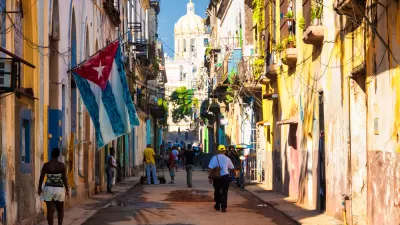The absence of redevelopment over the past 50 years has allowed Cuba to become "one of the world’s most significant but overlooked troves of Art Deco architecture." With many buildings in a state of disrepair, some are trying to raise awareness.
"Havana is renowned for its crumbling elegance, and over a million visitors each year stroll among the colonial buildings of Old Havana, many of which were built between the 16th and 18th centuries and carefully restored over the last 30 years," writes Victoria Burnett.
"But Havana, like many of the island’s provincial cities, is peppered with Art Deco houses, apartment buildings, cinemas, theaters, hospitals and office buildings that range from the bold, vertical skyscraper style to streamline moderne with its cool horizontal lines and curved corners. These landmarks are not as grand as the Chrysler Building in New York, and there is no Art Deco district like Miami Beach’s, but fans say there is an unusual wealth and diversity of stock, much of which has remained standing — if poorly maintained — through 50 years of Communist rule."
"As some 250 Cuban and foreign connoisseurs gathered last week in Havana for the World Congress on Art Deco, there was hope the event would foster wider recognition of the island’s Art Deco heritage and the urgent need to preserve it," says Burnett.
“Part of our purpose is to make a lot of noise,” said Gustavo López González, deputy director of the National Museum of Decorative Arts and one of the organizers. “If we in Cuba don’t appreciate the value of these buildings, how can we expect people from overseas to do so?”
FULL STORY: Dreams of Saving Art Deco Havana

Maui's Vacation Rental Debate Turns Ugly
Verbal attacks, misinformation campaigns and fistfights plague a high-stakes debate to convert thousands of vacation rentals into long-term housing.

Planetizen Federal Action Tracker
A weekly monitor of how Trump’s orders and actions are impacting planners and planning in America.

Chicago’s Ghost Rails
Just beneath the surface of the modern city lie the remnants of its expansive early 20th-century streetcar system.

Bend, Oregon Zoning Reforms Prioritize Small-Scale Housing
The city altered its zoning code to allow multi-family housing and eliminated parking mandates citywide.

Amtrak Cutting Jobs, Funding to High-Speed Rail
The agency plans to cut 10 percent of its workforce and has confirmed it will not fund new high-speed rail projects.

LA Denies Basic Services to Unhoused Residents
The city has repeatedly failed to respond to requests for trash pickup at encampment sites, and eliminated a program that provided mobile showers and toilets.
Urban Design for Planners 1: Software Tools
This six-course series explores essential urban design concepts using open source software and equips planners with the tools they need to participate fully in the urban design process.
Planning for Universal Design
Learn the tools for implementing Universal Design in planning regulations.
planning NEXT
Appalachian Highlands Housing Partners
Mpact (founded as Rail~Volution)
City of Camden Redevelopment Agency
City of Astoria
City of Portland
City of Laramie



























